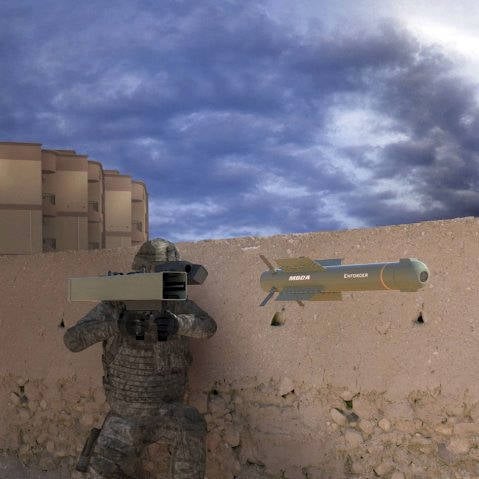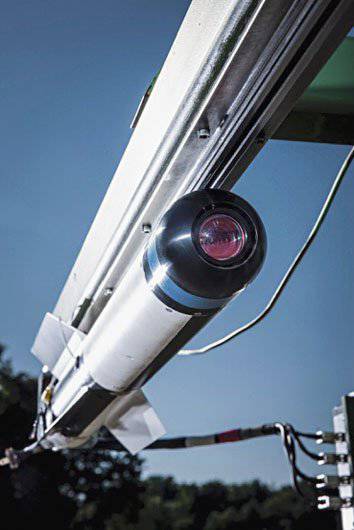In Germany, the development of a promising lightweight missile system MBDA Enforcer / KFK has begun
 The BMPD blog, citing Jane's International Defense Review magazine, announces the launch of the development of the new MBDA Enforcer / KFK missile system. Full-scale design work on the new project started at the end of last year. Next year, the developers plan to bring the new system to fire tests, and the adoption of the complex for service is scheduled for 2018 year.
The BMPD blog, citing Jane's International Defense Review magazine, announces the launch of the development of the new MBDA Enforcer / KFK missile system. Full-scale design work on the new project started at the end of last year. Next year, the developers plan to bring the new system to fire tests, and the adoption of the complex for service is scheduled for 2018 year.The creation of a promising light missile system started at the end of the last decade. The goal of the work carried out by the German branch of MBDA is the creation and launch of a new high-precision system for ground forces and other units capable of hitting various targets at short distances. With certain reservations, the Enforcer / KFK missile system is a direct competitor to the Israeli Rafael Mini-Spike system. Until recently, there was no detailed information about the new project.
According to reports, the current version of the project MBDA Enforcer / KFK appeared thanks to the three previous programs implemented by European experts. The Enforcer / KFK project uses MBDA LoCoPE (Low Cost Precision Effects), MBDA KFK and Concept Visions: Infantry Weapon System for 2030 and Beyond. The purpose of all these works was to study the prospects of infantry weapons, as well as the development of the shape of high-precision small-sized weapons. At the same time, the KFK project (Kleinflugkörper - “Small rocket”) was intended to create a demonstration rocket.
In the autumn of 2012, MBDA conducted two Enforcer / KFK rocket test launches. In both cases, the prototype missiles successfully overcame a given distance. The tests were considered successful. It has been reported that test launches will also be held in 2013. Apparently, later new tests really took place, which eventually allowed to move from the elaboration of individual programs to the creation of a full-fledged project of rocket weapons.
At the moment, the Enforcer / KFK missile system is as follows. Small-sized guided missile must be supplied in a transport and launch container (TLC) of square section. On the container there are fasteners for installation of sighting devices. TPC missiles are disposable and can be thrown out after launch. The sighting device, in turn, must be removed and used for the next shot, being installed on a new TPK.
The Enforcer / KFK rocket with a container weighs about 9 kg. It has a cylindrical body with a diameter of 86 mm. On the side of its body are stabilizers and steering wheels. The stabilizer wings are located in the middle of the hull, the rudders - in the tail. To place the rocket in the TPK, all planes are collapsible.
The rocket is equipped with a starting and marching solid-fuel engines, allowing you to attack targets at distances from 100 to 1800 m. In this case, the minimum firing range can be reduced to 50 m, and the maximum is set in accordance with the requirements of the German armed forces. A curious feature of the starting engine and the missile defense complex is the possibility of firing from closed rooms, for example, from a building window. The minimum size of such a room is 5х4х2,5 m.
The Enforcer / KFK rocket is equipped with an optical-electronic homing head capable of “memorizing” the target and heading for it. An important innovation is the original image stabilization technology, first used in the new project. In order to simplify the design, the optical element of the GOS is mounted not on a movable base, but on a rigid mount. Image stabilization is done electronically.
 The GOS used in theory is capable of operating and driving a rocket, receiving a reflected laser beam. In addition, in the future it may be possible to control the rocket during the flight. Such modes of operation of the homing head can significantly increase the flexibility of application.
The GOS used in theory is capable of operating and driving a rocket, receiving a reflected laser beam. In addition, in the future it may be possible to control the rocket during the flight. Such modes of operation of the homing head can significantly increase the flexibility of application.The Enforcer / KFK rocket will use penetrating high-explosive warhead to hit targets. The development of this unit is now engaged in the company TDW, which is part of the concern MBDA. Subversion control should be carried out using a programmable fuse. Depending on the type of target, the fighter will be able to choose an undermining when in contact with the target, with some delay or in the air.
Search for the target and control of the complex will be carried out using a removable aiming block Airbus DS Optronics DynaHawk. The two-kilogram unit must be mounted on the TLC before start-up and removed after the attack. The sighting unit includes a telescopic sight with an increase in 5,5x, a laser range finder, an automatic target pickup and tracking system, as well as a set of sensors for determining air temperature, atmospheric pressure and wind speed.
It is reported that one fighter can carry a set of two Enforcer / KFK missiles in transport-launch containers and one sighting unit. Thus, one soldier carrying a weight of about 20 kg will be able to conduct two attacks of targets at a distance of up to 1800 m. From the point of view of tactics of use, the new system will take an intermediate position between rocket launchers and high-grade anti-tank missile systems. All this should have a positive effect on the firepower of the units.
It is known that the Enforcer / KFK missile system has a large modernization potential. So, at the moment the maximum firing range is declared at the level of 1,8 km. At the same time, during the test firing, the KFK prototype rocket managed to achieve a range of 2,9 km. Plans to improve the guidance system and the sighting unit can also lead to an increase in the characteristics of the entire complex.
The full-fledged development of the MBDA Enforcer / KFK project started in December 2014. In the near future, German specialists will be engaged in design work, and for 2016 the first test firing of a new rocket is planned. The first deliveries to customers are expected to be carried out in 2018. The starting customer is likely to be the armed forces of Germany. In addition, as positive News On the progress of the project, a new light missile system may be of interest to the armies of other countries.
On the materials of the sites:
http://bmpd.livejournal.com/
http://flugrevue.de/
http://mbda-systems.com/
http://flightglobal.com/
Information